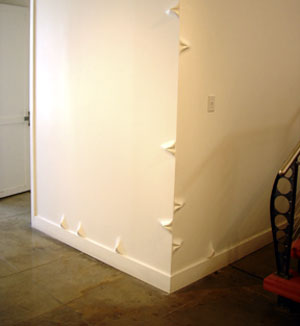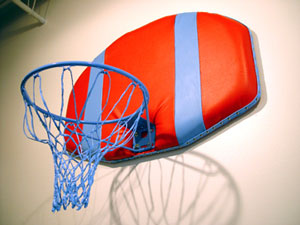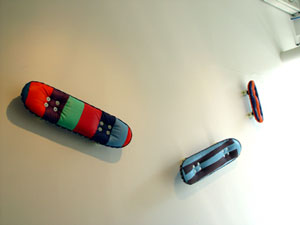Certain old tricks somehow find a way to feel new almost every time they are performed. A love song in a minor key comes on the radio and makes us feel sad, and we take a few quiet sincere moments to think of some past boyfriend/girlfriend.
We really did have some good times didn’t we? A kid does a triple flip off a rope swing, and it just seems so brave (and also so coordinated!) A postcard depicts an illustration of Jesus, and then, with a simple turn of the hand, he is crying! And then not crying…. and then crying again!
Old tricks, therefore, are not necessarily tired tricks. Relying on love, fear, desire and transformation, these events serve to inform and validate our central and fundamental experiences.
Analia Segal and Ethel Shipton’s new work in a show titled Feminizing Forms? occupies a place in a post-Minimalist terrain defined by artists interested in addressing and reinterpreting the practices of Minimalism and Pop Art, without overtly addressing the historical precedents. Ethel Shipton’s upholstered athletic gear and Analia Segal’s architectural interventions instead rely on a relatively old trick: transforming something into something else, to create work that is complex and personal.
The work of Analia Segal consists of scattered, hand-sized forms emerging seamlessly out of the white expanse of the gallery walls. The forms, mostly gathered around corners and baseboards, ripple through the space, transforming rigid walls into something softer and more malleable. Like a tongue moving over the interior wall of a cheek, the white forms create a relief that is subtle yet insistent. The forms look as if they been pushed or pinched by oversized fingers, creating sculptural gestures which can easily be read as stylized nipples, breasts, and genitals. But unlike Eva Hesse, whose use of soft, seemingly organic materials created work that was both visceral and abstractly sexual, or Nicola Constantino, who creates clothing using hyper-realistic silicon castings of human skin, nipples, anuses, and navels, the materiality of Segal’s forms — the white plaster and smooth finish — denies an overtly sexual reading of the work.
What is engaging and even thrilling about this work is not its subtle suggestions of human anatomy, but its properties of transformation. Like a hologram, Segal’s gallery walls move seamlessly between movement and stillness, analytical structure and organic form.
Segal alters the surface of the walls, but creates the illusion that she has not. There is the inexplicable feeling that these gallery walls have always had the potential to ripple and move, housing some hidden anthropomorphic life force beneath the smooth white exterior.
Ethel Shipton’s hybridized vinyl sporting gear also trades in the tricks of transformation. Upon entering the gallery, one is presented with a variety of familiar forms and equipment relating to basketball, baseball, skate culture, street signs, industrial manufacturing, and gymnastics; all presented and installed in unfamiliar and unusual ways. Multi-colored vinyl upholstered skateboards crawl the gallery walls, rounded vinyl ramps, cubes, and upholstered arrows are placed throughout the gallery, creating the impression of an obstacle course, or a warm up room for aspiring gymnasts.
There is a predominance of bright “team” colors, broad irregular stripes, and a simplicity and geometry to the chosen forms that call to mind the paintings of Frank Stella or Brice Marden. Like an updated, user-friendly version of Louise Nevelson’s ubiquitous black, Shipton uses colored vinyl to formalize and reposition the aesthetics of sporting equipment.
One of the most interesting and complex pieces in the show is a pink and blue upholstered basketball backboard and net. The upholstered vinyl backboard, striped in bubblegum pink and powder blue, supports a paint-dipped net, rigid and ornate. The physicality of the backboard contrasts with the delicate shadows, like spider webs stretched across the wall, cast by the net.
What is interesting about Shipton’s work is that these pieces, although transformed, have not lost their original function, but rather have been hybridized to include new utilitarian possibilities. Although it is somewhat ridiculous, Shipton has made these sports “safer” by rounding their edges and padding their surfaces. Ramps and skateboards become seats and daybeds, inviting participation from gallery visitors beyond the demographic of the athletically inclined.

Analia Segal, Untitled, wall installations, 2003... Plaster, compound joint, paint... Dimensions variable
Shipton’s work, while formally complex, is friendly. Unlike material transformations resulting in conceptual ambiguity (Meret Oppenheim’s Fur Covered Cup comes to mind), Shipton’s vinyl padding almost seems like a gesture of goodwill. Shipton’s work is also funny. There is an awkwardness, a clunkiness, that results from the padding and tucking of the forms. One gets the feeling that some of the potential for Xtreme Speed might have been lost on the sewing room floor.
Both Segal and Shipton respond to their surroundings by transforming, or expanding, the functions of pre-existing objects or structures while preserving their elemental form. Their work introduces new words into established languages, expanding our vocabulary of formal and functional possibilities. Both artists introduce elements of the physical body into their work either directly or indirectly, intervening, altering and questioning the manufactured, homogenous, and often times hard-edged world we occupy. Their work involves the customizing, the humanizing of our largely industrial terrain.
Feminizing Forms? New Work by Analia Segal and Ethel Shipton was curated by Kate Green. The exhibition is on view at Finesilver Gallery in San Antonio through November 8, 2003.
Images courtesy the artists and Finesilver Gallery.
Joey Fauerso is an artist and co-director of the Bower gallery. She lives in San Antonio, TX.






